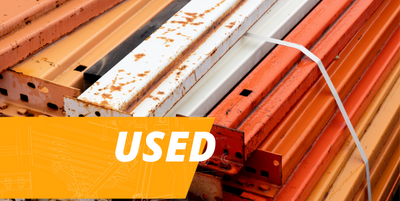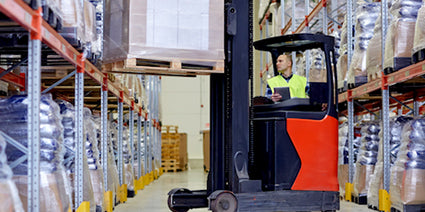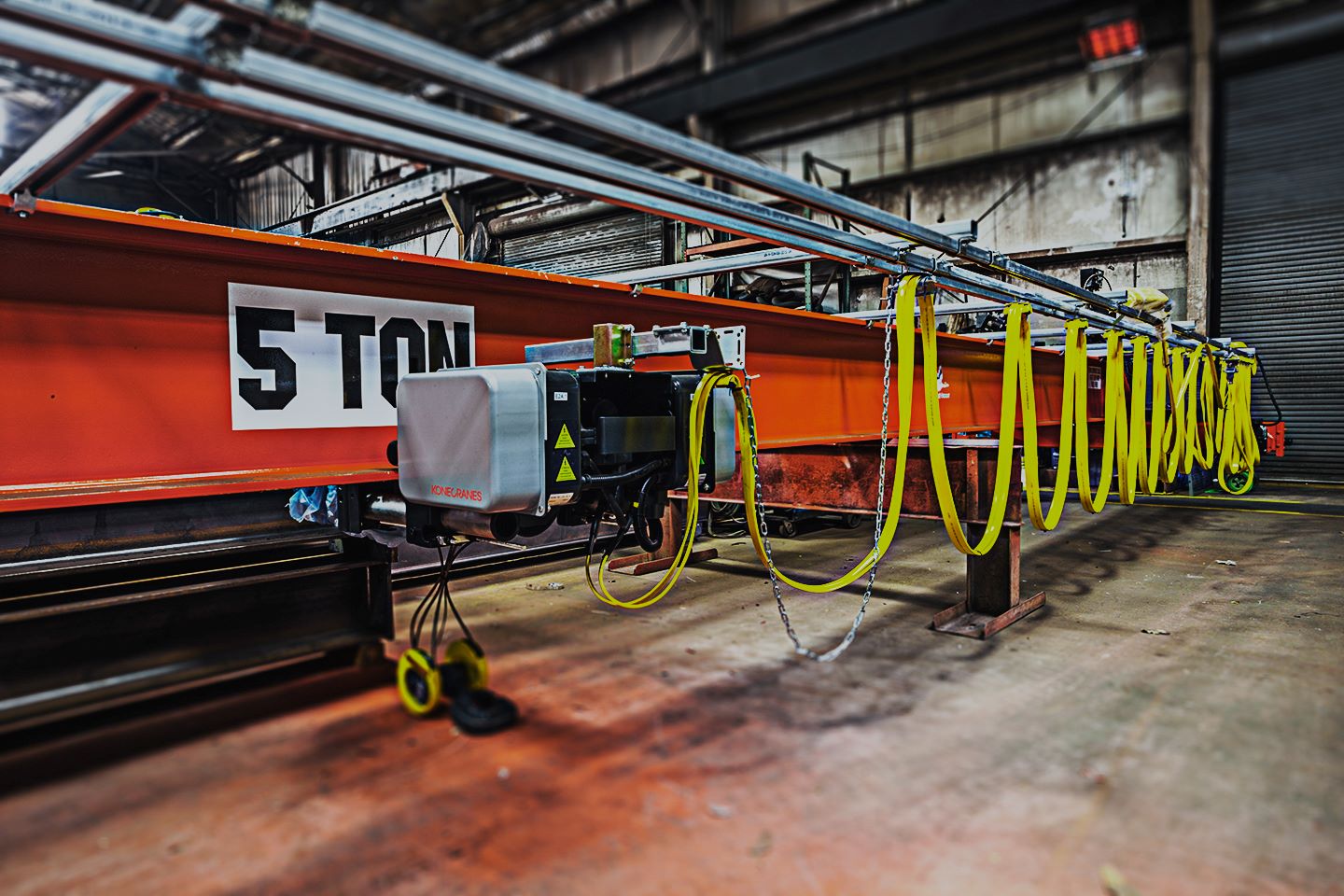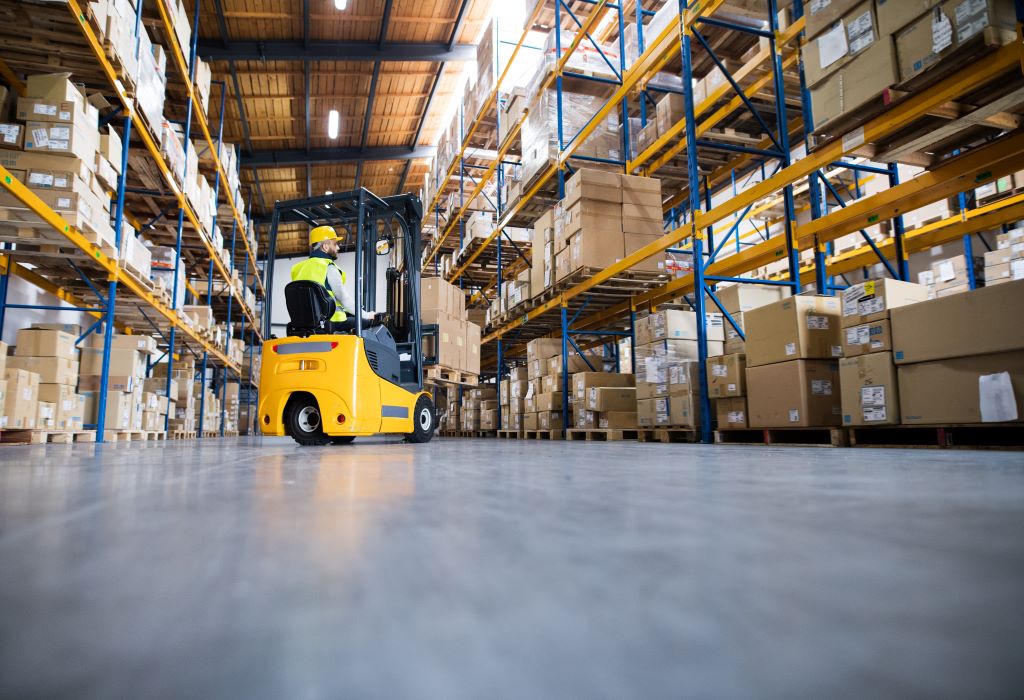Your Cart is Empty

Maximizing Warehouse Safety with Specialized Netting Solutions
In an often unpredictable warehouse environment, safety is paramount. It's the cornerstone of efficient operations, safeguarding the workforce, maintaining productivity, and mitigating the financial and legal consequences of workplace accidents.

Hoj Innovations and WarehouseOS value employee safety for our clients as well as our own crew. We use only quality products from trusted partners like InCord Custom Safety Netting Solutions.
Safety netting emerges as a key protective measure, versatile enough to address various hazards. It serves as a barrier against falling objects, a safety measure for workers at heights, and a protective layer for goods in transit, significantly reducing the risk of accidents and enhancing worker well-being.
Safety netting's adaptability is evident in its diverse applications, from Rack Guards preventing merchandise falls to Conveyor Guards ensuring operational safety. This post highlights the multifaceted role of safety netting in promoting a safer, more productive warehouse environment. It emphasizes the importance of specific netting types like Elevating Rack Guards and Service Bay Nets in safeguarding different warehouse zones.
Netting protects valuable inventory when a warehouse is in use, but can also provide an important layer of safety during demo projects.
The discussion underscores that safety netting is more than a precautionary tool; it's a commitment to maintaining the highest safety standards in the complex warehouse setting. It's about fostering a safety culture where every net, protocol, and measure signifies the value placed on human life, well-being, and the continuity of warehouse operations.
1. Rack Guard
In the context of modern warehouse operations, the role of Rack Guards is pivotal for safety and organization. These guards, particularly when designed as safety netting, provide a crucial barrier that prevents goods from falling off racks, thereby ensuring the safety of personnel and the integrity of stored items.
Let's look into the various types of Rack Guards:- Vertical Safety Netting Rack Guards: These are essential for preventing items from falling off the backside of racks. Their design focuses on strength and flexibility, offering a reliable solution for securing even heavy goods.
- Horizontal Safety Netting Rack Guards: Positioned at different levels within pallet racking systems, these guards are instrumental in protecting both workers and products from the risks associated with items falling from higher shelves. Their horizontal orientation is particularly effective in absorbing and dispersing the force of falling objects.
- Sliding Safety Netting Rack Guards: These guards combine the protective qualities of safety netting with the convenience of a sliding mechanism. This design allows for easy access to stored items while ensuring their security when not in use.
- Customizable Safety Netting Solutions: Recognizing the unique requirements of each warehouse, safety netting can be tailored in terms of size, mesh density, and material. This customization ensures that each setup provides optimal protection and functionality.
In summary, Rack Guards are an indispensable component in maintaining the high standards of safety and efficiency in warehouse operations. Their diverse applications and customizable options make them a versatile solution for a variety of storage environments.
2. Elevating Rack Guard
The Need for Elevating Rack Guards in High-Stack Storage Areas
In warehouses with high-stack storage areas, Elevating Rack Guards are essential for safety. These areas, while space-efficient, pose risks of goods falling from great heights. Elevating Rack Guards, especially those with robust safety netting, are designed to counter these risks. They provide a flexible safety barrier that adapts to different heights and load levels, significantly reducing the danger of falls that could cause injuries or damage.
A key feature of Elevating Rack Guards is their dynamic protection. Warehouse rack contents often change, with items frequently added or removed. These guards adjust to such variations, moving vertically to ensure optimal positioning and protection regardless of stack height. This adaptability not only bolsters safety but also maintains easy access to goods and efficient operations.
Integrating Elevating Rack Guards into existing warehouse safety protocols is seamless. They complement and enhance current safety strategies without disrupting operational flow. Their installation is tailored to the warehouse's processes, reinforcing a safety culture without hindering efficiency. Training and awareness are crucial, ensuring staff understand and respect these guards as part of the safety system.
In summary, Elevating Rack Guards are a significant safety advancement in high-stack storage areas. Their dynamic, robust nature makes them an active safety feature in daily warehouse operations. By integrating with existing protocols, they enhance the overall safety environment, balancing safety with operational efficiency.

3. Conveyor Guard
The Role of Conveyor Guards in Preventing Accidents Around Conveyor Systems
Conveyor Guards are crucial in warehouses, where conveyor systems are central to operations but come with risks like entanglement, slips, and falls. These guards, often featuring robust safety netting, act as a protective barrier between the conveyor and personnel, significantly reducing injury risks and ensuring compliance with safety standards.
There are different types of Conveyor Guards, each tailored to specific conveyor configurations:
- Under-Guarding Netting: Positioned beneath conveyor belts, this netting catches falling debris or products, preventing trip and fall hazards on the floor.
- Side-Guarding Netting: Installed along the sides of conveyor belts, these guards stop items from slipping off and protect workers from the conveyor's moving parts.
- Overhead-Guarding Netting: For overhead conveyors, this netting acts as a safety canopy, safeguarding workers from falling goods.
Each type is designed to address particular operational hazards, ensuring comprehensive protection without compromising conveyor functionality.
The benefits of Conveyor Guards are significant:
- Enhanced Safety: They drastically reduce accidents by serving as a physical barrier between workers and conveyor systems.
- Operational Continuity: By containing dislodged items, these guards prevent disruptions and damage, aiding in smooth workflow.
- Compliance with Safety Standards: Conveyor Guards are key to meeting safety regulations, reflecting the warehouse's commitment to a safe work environment.
- Worker Confidence: The presence of these guards boosts morale and productivity, as workers feel secure in their environment.
In summary, Conveyor Guards, especially those with safety netting, are vital for warehouse safety. They prevent accidents, are adaptable to various conveyor types, and offer multiple operational benefits, making them an essential investment for any warehouse prioritizing safety, efficiency, and a positive work culture.
4. Truck Nets
Importance of Truck Nets in Securing Cargo During Transportation
Truck Nets are vital in the logistics and transportation sector, ensuring cargo security during transit. These nets are crucial not just for keeping goods in place, but also for road safety.
Unsecured cargo can lead to accidents, posing risks to other road users and potentially damaging the goods. Truck Nets help prevent items from falling or shifting, which could unbalance the vehicle, thus promoting safer transportation and protecting cargo integrity.
There are various types of Truck Nets, each designed for different cargo and trucks:- Heavy-Duty Truck Nets: Ideal for securing heavy or bulky items, these are made from strong materials and are perfect for flatbed trucks and large trailers.
- Mesh Truck Nets: Suitable for smaller items needing containment, their mesh design allows for visibility and ventilation, making them great for goods like agricultural produce.
- Adjustable Truck Nets: These versatile nets can be adapted to different load sizes and truck beds, ideal for operations handling varied cargo types and volumes.
- Weather-Resistant Truck Nets: Built to withstand harsh weather, these are crucial for long-haul transportation where goods are exposed to elements like rain and wind.
- Compliance with Safety Regulations: Adhering to legal standards and avoiding fines.
- Road Safety: Keeping roads safe by preventing cargo-related accidents.
- Cargo Integrity: Ensuring goods arrive in their intended condition, maintaining quality and value.
- Reputation Management: Building a reputation for reliability and safety in the logistics and transportation industry.
In summary, Truck Nets are essential for the safe and efficient transport of goods. They secure cargo, come in various types for different needs, and have significant legal and safety implications. Their use is key to safer, more reliable, and compliant transportation practices.
5. Loading Dock Net
The Critical Role of Loading Dock Nets in Preventing Fall Accidents

Loading Dock Nets are essential in warehouses and distribution centers, particularly for enhancing safety at loading docks, bustling hubs where goods transition between vehicles and storage areas. These nets, especially when designed with robust safety netting, serve as a crucial barrier at the dock's edge, preventing falls of workers and equipment, a common hazard in such active areas. They're not just a safety feature but a fundamental part of creating a secure working environment.
Key benefits of Loading Dock Nets include:- Fall Prevention: They provide a strong barrier, significantly reducing fall risks.
- Containment of Goods: These nets help contain items that might accidentally approach the dock's edge, preventing potential injuries or damage.
- Visibility and Awareness: Often designed with high-visibility materials, these nets act as a visual reminder for workers to stay cautious, fostering a safety-first culture.
- Size and Fit: Customization to the dock's dimensions is crucial for comprehensive coverage.
- Material Strength: The netting should be durable enough to handle typical loads and forces at the dock.
- Ease of Access: Nets should not impede operational efficiency; options like retractable or removable nets can offer a balance between safety and functionality.
- Installation Quality: Secure anchoring and regular inspections are vital for maintaining effectiveness.
- Compliance with Regulations: Ensuring that the nets meet safety standards and regulations is essential for both practical safety and legal compliance.
In summary, Loading Dock Nets are key to warehouse safety, especially in high-risk loading dock areas. They prevent falls, contain goods, and promote safety awareness. Proper customization and installation are vital for ensuring these nets provide robust, reliable, and compliant safety solutions, thereby contributing to a safer, more efficient, and conscientious operational environment.
6. Skylight Net
The Often-Overlooked Importance of Skylight Nets in Warehouse Safety
Skylight Nets are a crucial, though sometimes overlooked, aspect of warehouse safety. While skylights offer natural light and energy savings, they also pose a fall risk during routine maintenance or accidental missteps. Skylight Nets, designed as safety netting systems, provide a vital protective barrier over skylights, ensuring the advantages of natural lighting don't compromise safety.
Key Functions of Skylight Nets:
- Fall Protection: They cover skylights with strong, resilient netting, significantly reducing the risk of falls. This is especially important for maintenance staff or others accessing the roof.
- Regulatory Compliance: Many safety regulations mandate securing potential fall hazards. Skylight Nets help warehouses meet these standards, avoiding fines and legal issues, and most importantly, maintaining a safe working environment.
- Material Durability: The netting should withstand elements like UV exposure, rain, and temperature changes without losing strength.
- Load Capacity: It's crucial that the net can support the weight of a person, tools, or debris, ensuring it remains intact under pressure.
- Fit and Coverage: Nets should be sized correctly for the skylight, providing full coverage without gaps. Custom sizes may be needed for non-standard skylights.
- Installation Quality: Secure anchoring to the roof structure is essential, and the installation shouldn't compromise the roof or skylight's integrity.
- Maintenance Access: While prioritizing safety, the design should still allow easy access to the skylight for cleaning and maintenance.
- Aesthetics: Consider the visual impact of the nets, especially in areas visible to customers or employees. Nets should provide safety without detracting significantly from the building's appearance.
In summary, Skylight Nets are a vital element in warehouse safety, offering crucial protection against fall hazards and aiding in compliance with safety regulations.
When selecting and installing these nets, factors like material durability, load capacity, fit, installation quality, maintenance access, and aesthetics should be carefully considered. This ensures that Skylight Nets effectively safeguard workers while maintaining operational efficiency and building aesthetics.
7. Cart Net
Explaining the Use of Cart Nets in Securing Materials During Internal Transport
Cart Nets are essential in warehouse operations for securing materials during internal transport. As carts loaded with goods move through aisles and work areas, the risk of items spilling or falling is significant. Cart Nets, designed as specialized safety netting, are draped over or wrapped around the cart's contents to keep items contained and secure.
This containment is crucial not just for preventing the loss of goods but also for ensuring clear, safe pathways and minimizing accident risks caused by spilled or fallen items.
Advantages of Using Cart Nets:
- Prevention of Spillage: They keep items securely on the cart, reducing spillage even when the cart is jostled or takes sharp turns.
- Safety for Personnel: By reducing spillage, Cart Nets lower the risk of slip-and-fall accidents, a common workplace injury.
- Protection of Goods: They safeguard goods from damage, reducing waste and saving costs.
- Operational Efficiency: With secure goods, workers can move faster and more confidently, enhancing internal transport efficiency.
- Size and Fit: The net should be the right size for the cart, covering the load completely without being cumbersome.
- Material Strength: Choose a durable material that can hold the weight and type of goods typically transported, and withstand daily use.
- Ease of Use: Opt for nets that are easy to secure and remove, with user-friendly fastening systems.
- Visibility: High-visibility colors or markings are beneficial, especially in areas with mixed equipment or pedestrian traffic, to prevent collisions.
- Customization Options: Consider customizable nets for different loads or cart types, depending on the variety of goods transported.
- Maintenance and Cleanliness: Select materials that are easy to clean and maintain, ensuring hygiene and presentability.
In summary, Cart Nets are a straightforward yet highly effective tool for enhancing safety and efficiency in warehouse operations. They secure materials during transport, prevent spillage and accidents, protect goods, and contribute to a smoother workflow.
Choosing the right Cart Net, tailored to your operation's needs, ensures this safety feature integrates seamlessly into your warehouse's rhythm and flow.

8. Handrail and Mezzanine Safety
The Critical Role of Handrails and Safety Netting in Mezzanine Areas
Handrails and safety netting play a crucial role in ensuring safety in mezzanine areas of warehouses and industrial settings. These elevated spaces, while increasing usable space, also bring heightened risks of falls. Handrails provide physical support to prevent slips and falls, while safety netting offers an additional layer of protection, catching objects or individuals that might fall, thus preventing injuries and damage.
Key Aspects of Mezzanine Safety:- Compliance with Regulations: Adhering to occupational safety standards, like OSHA guidelines in the U.S., is essential for legal compliance and ensuring the highest safety level.
- Regular Inspections and Maintenance: It's important to regularly check handrails and safety netting for stability and potential wear or damage.
- Training and Awareness: Personnel should be trained in proper mezzanine use, emphasizing the importance of handrails and safety netting. Awareness campaigns can reinforce safety protocol adherence.
- Integrated Safety Systems: Combining handrails with robust safety netting creates a comprehensive barrier, with systems available that integrate these components seamlessly.
- Customizable Solutions: Safety solutions can be tailored to fit specific mezzanine dimensions and shapes, accommodating unique spaces or providing extra protection where standard solutions fall short.
- Advanced Materials: Using advanced materials in handrails and safety netting ensures greater durability and strength, suitable for demanding environments.
- Visual and Physical Deterrents: Handrails and safety netting also act as visual cues, marking safe zones and promoting safety awareness among personnel.
In summary, handrails and safety netting are indispensable for mezzanine safety. These features, supported by regulation compliance, regular maintenance, and innovative enhancements, are crucial in any facility with elevated spaces. Investing in these safety solutions not only protects personnel and assets but also signifies a commitment to a culture of safety and responsibility.
9. Lifting and Rigging Products
In warehouse operations, lifting and rigging products are key players, working alongside safety netting to ensure the safe movement of goods. These include:
- Hoists and Cranes: For vertical movement of heavy items.
- Slings: Flexible straps used with lifting equipment for load support and security.
- Shackles and Hooks: Connectors for lifting equipment, slings, and loads.
- Wire Ropes and Chains: Strong materials for lifting and securing heavy loads.
The Importance of Quality and Compliance in Lifting and Rigging:
- Quality Assurance: High-quality equipment is crucial for handling heavy loads safely and reducing the risk of accidents due to equipment failure.
- Compliance with Standards: Adhering to safety standards set by regulatory bodies ensures every lifting operation is as safe as possible.
- Regular Inspections and Maintenance: Essential for maintaining equipment quality and compliance, ensuring any wear or damage is addressed promptly.
- Layered Safety Approach: While lifting and rigging equipment securely move loads, safety netting adds a secondary layer of protection, containing the load in case of equipment failure.
- Prevention of Accidental Falls: Properly secured loads minimize fall risks, and safety netting is there as a backup to catch any fallen items, protecting goods and workers.
- Enhanced Worker Confidence: Robust safety measures boost worker morale and productivity, knowing they are operating in a safe environment.
In summary, lifting and rigging products are essential in warehouse operations, especially when used in conjunction with safety netting. Ensuring quality, compliance, and proper use of these products not only facilitates safe and efficient goods movement but also forms a crucial part of the overall safety infrastructure. This synergy between lifting and rigging equipment and safety netting creates a comprehensive safety ecosystem, underlining a commitment to a safe and productive work environment.
10. Service Bay Nets
The Necessity of Service Bay Nets in Automotive and Equipment Service Areas
Service Bay Nets are essential in automotive and equipment service areas, environments rife with potential hazards. These specialized safety nets are strategically placed to catch falling objects, contain spills, and segregate areas, ensuring a controlled and secure environment for technicians.
Benefits of Service Bay Nets in Maintenance Areas:- Containment of Tools and Parts: They catch tools or parts that might fall during maintenance, protecting workers and preventing damage to vehicles or equipment.
- Spill Containment: Service Bay Nets can contain fluid spills or broken parts, reducing slip hazards.
- Area Segregation: In larger service areas, these nets create physical barriers, segregating work zones and restricting unauthorized access to hazardous areas.
- Custom Fit and Design: Tailoring the nets to the specific dimensions and layout of the service area ensures comprehensive coverage without hindering work or access.
- Material Durability: The netting should withstand typical service bay conditions, including exposure to fluids and frequent impacts.
- Ease of Installation and Access: Nets should be easy to install and, if necessary, move or remove for access, allowing quick and safe access to all service bay areas.
- Compliance with Safety Standards: It's important that Service Bay Nets meet relevant safety regulations, ensuring both practical safety solutions and legal compliance.
- Maintenance and Cleanliness: Opt for materials that are easy to clean and maintain, keeping the nets effective and hygienic in the demanding service bay environment.
In summary, Service Bay Nets play a vital role in automotive and equipment service areas by containing hazards, protecting workers, and maintaining an organized workspace. Careful consideration of customization, material, installation, and maintenance ensures that these nets provide robust, reliable, and compliant safety solutions, contributing to a safer, more efficient, and professional operational environment.
Conclusion
Throughout our discussion on specialized netting solutions, it's evident that safety netting is a fundamental aspect of warehouse safety. From Rack Guards preventing merchandise falls to Service Bay Nets managing hazards in maintenance areas, each netting type plays a vital role in ensuring safety. They operate quietly but effectively, keeping the dynamic activities in warehouses, service areas, and transport hubs safe and accident-free.
For warehouse managers and safety officers, the takeaway is clear: prioritizing and continually enhancing safety netting is not only about compliance but also a moral responsibility. It involves creating a workspace where safety is integral to every aspect of operations. The goal is to ensure that every employee working in these environments is safe and secure.
In conclusion, we invite those responsible for safety to proactively enhance their netting solutions. Whether it's updating Rack Guards to the latest standards or considering Service Bay Nets for better hazard management, each step contributes to a safer, more efficient workspace.
We're here to help with consultations and information about our products, assisting you in evaluating your needs and implementing solutions that surpass safety expectations. Let's collaborate to build a robust safety network, ensuring every operation, regardless of size, is conducted with top-notch safety measures in place.








